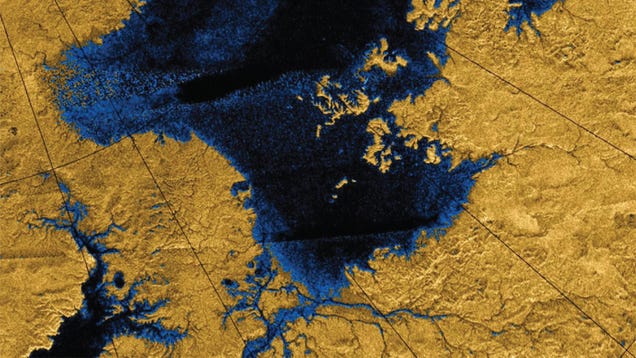Mars and Saturn’s moon Titan are of a shared scientific interest: the two worlds boast river channels similar to those on our own planet.
Though Mars’ water networks dried up long ago, Titan’s liquid methane and ethane rivers are still coursing on the moon’s surface today. Both kinds are of scientific interest because they could reveal the role rivers play in shaping the worlds’ environments. Given water’s role in supporting life as we know it, the waterways and—er, hydrocarbonways—may yet clue researchers into signs of life beyond Earth.
Now, a team of researchers has calculated the dried-up channels on Mars and the active swaths of Titan using imagery from spacecraft orbiting the worlds and, in Mars’ case, the rovers traversing its dusty surface. The team’s research was published today in the Proceedings of the National Academy of Sciences.
“On Mars, it gives us a time machine, to take the rivers that are dead now and get a sense of what they were like when they were actively flowing,” said Taylor Perron, a planetary scientist at MIT and the study’s co-author, in an MIT release. “What’s exciting about Titan is that it’s active. With this technique, we have a method to make real predictions for a place where we won’t get more data for a long time.”
That will change in the mid-2030s, when NASA plans to get an aerial drone on the Saturnian moon. The Dragonfly mission is expected to launch around 2027, and will vastly improve the understanding of Titan that has, so far, been built on data taken from a distance. There are even farther-off designs for planes that could fly through Titan’s dense skies just as easily as its methane seas, but we’re getting ahead of ourselves.
Without data from the ground on Titan, Perron’s team relied on imagery of Titan taken by Cassini, which disintegrated in Saturn’s atmosphere in 2017 after 20 years in space.
The researchers calculated the flow rate of rivers on Mars and Titan using equations originally designed to measure flow rates in Earth’s waterways; the equations were made by Gary Parker, a hydrologist at the University of Illinois and a co-author on the new work, who originally wanted to understand how the width, depth, and slopes of Earth’s river systems defined the waterways’ flow.
The equations were tweaked to apply to Mars and Titan—specifically, the rivers that flow into Titan’s massive lakes and the dried-up river deltas that fan into craters on Mars thought to once harbour lakes.
The researchers found that rivers probably flowed for 100,000 years in Mars’ Gale Crater, where the Curiosity rover still roams, and at least 1 million years around Jezero Crater, where the Perseverance rover is seeking signs of ancient microbial life.

“The Martian rivers we studied were not just fleeting; they appear to have flowed over prolonged time periods during which conditions favourable to life may have been maintained,” Perron told Gizmodo in an email. “The flow rates in the rivers we studied on Titan may be as large as in big rivers on Earth, even though Titan is smaller than Earth.”
Maps of Titan have revealed a remarkable world, replete with massive sand dunes, methane rainstorms, and hydrocarbon seas. While alien in many ways, Titan has an atmosphere and coursing rivers and seas, making it surprisingly like Earth.
Images of Titan taken by the now-decommissioned Cassini spacecraft have revealed previously unknown aspects of the planet, which is shrouded in a thick atmosphere. The Huygens spacecraft even landed on Titan’s surface in 2005, and managed to send a picture to Earth from the moon before it went dark about an hour later.
“Titan is the most Earth-like place,” said Samuel Birch, also a planetary scientist at MIT and the study’s lead author, in the MIT release. ”We’ve only gotten a glimpse of it. There’s so much more that we know is down there, and this remote technique is pushing us a little closer.”
Until Dragonfly arrives on Titan, scientists will have to work mostly with Cassini’s data to understand Titan’s surface. A Titan orbiter mission, Perron said, would give researchers a view “like putting on glasses for the first time.”
For now, questions remain, including why there is a dearth of river deltas on Titan. The moon’s rivers have the capacity to carry plenty of liquid methane and ethane and have lots of sediment, but don’t form the same multi-pronged features of Earthly waterways. The researchers are still working on why that might be, and the reason will likely improve science’s understanding of Titan itself.
